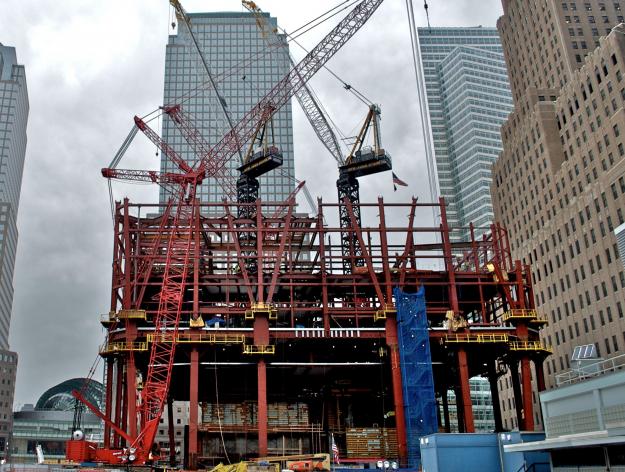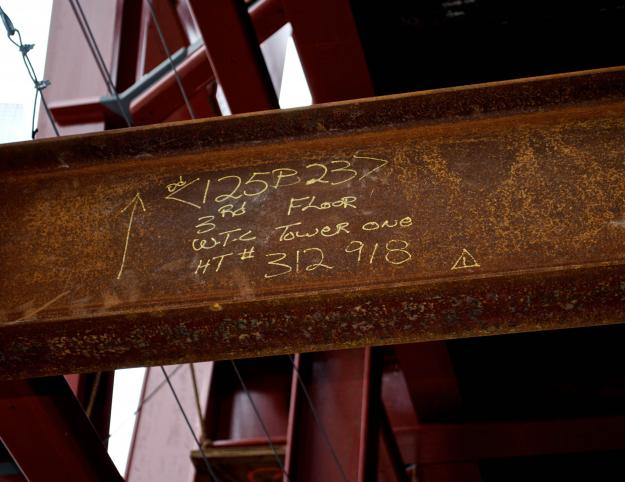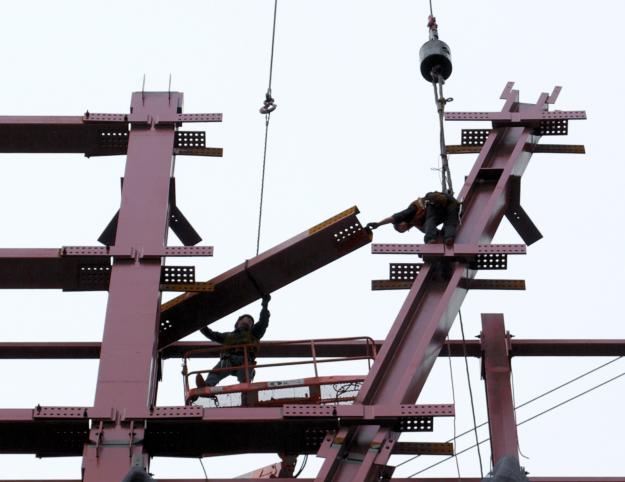World Trade Center Construction: The December 2009 Photo Tour!
By Eliot Brown December 7, 2009 12:39 pm
reprints














There’s a narrative that has been playing out over the redevelopment of the World Trade Center site practically since redevelopment was first discussed: delays, infighting; ballooning costs. And while this still dominates the conversation—there is currently a standoff over when to build office towers on the eastern portion of the site, and how they should be financed—there is, in fact, quite a bit of construction going on at the 16-acre site.
Last week, we headed downtown to shoot some photos at the giant construction site, where the Port Authority of New York and New Jersey, which owns the property, took us around to show us a few different elements.
First up: the Freedom Tower (it’s now officially called 1 World Trade Center), which now has steel rising four stories up, surrounding a thick concrete core. The first floor is unusually tall, with a giant podium serving as a strong base for the building, putting the tallest steel above 160 feet.
We first went up to the third floor, at the top of the blue mesh cloth-sheathed stairs in the center of the photo.
-Eliot Brown
(Photos by Brian Letwin)
Brian Letwin
There's a whole lot of steel work going on now at the Freedom Tower. The center of it is a very thick concrete core (reinforced with steel rebar), and the exterior and floors are all steel beams.
Brian Letwin
Setting the beams into place isn't for the faint of heart. As a crane lowers the beams, workers, in harnesses, guide the steel down as they stand on small beams and cables.
Brian Letwin
Another worker, with 7 World Trade Center in the background, puts steel into place.
Brian Letwin
A worker on the south face of the Freedom Tower.
Brian Letwin
Two enormous tower cranes rise in the middle of the building (this is the southern crane). The cranes lift steel around them to fill out the skeleton. Once the steel is high enough, the cranes jump four stories or so, and the process repeats.
Brian Letwin
Here's the really tall lobby. At the back (with all the red scaffolding) is the concrete core, which surrounds the guts of the building, such as the stairs and elevators. In all the planned World Trade Center towers (and Larry Silverstein's 7 World Trade Center, completed in 2006), the concrete cores are very thick--the Freedom Tower's looks to be about three feet--acting as a strong, stable central support.
Brian Letwin
We then went down to the Memorial plaza. The National September 11 Memorial and Museum takes up 8 acres on the site, with two giant waterfalls planned as the centerpieces that were nearly the size of the Twin Tower footprints. Here's the base of the waterfall (and here's a rendering of what it should look like)
Brian Letwin
Here’s a look at edge of the plaza, which is at street level, overlooking a waterfall (on the other side of the fencing).
Brian Letwin
And here's the cavernous space below the plaza, some of which will be the giant museum and other parts of which will be mechanical equipment.
Brian Letwin
Known simply as the "1-Box," this less-than-sightly stripe running horizontally through the photo is the tube that holds the No. 1 subway line. In an extraordinarily expensive effort--think nine figures--the box has been propped up by stilts as it runs north-south through the site as construction goes on around it. Cutting off the 1-train at Chambers Street while the site was built out over years would have saved money, though apparently would have had a highly disruptive effect on other subway lines.
Brian Letwin
The PATH train runs through the site as well, further complicating matters.
Brian Letwin
Here's developer Larry Silverstein's World Trade Center Tower 4. There's now steel rising above street level, though Mr. Silverstein has said he would have to soon stop construction without a resolution over how his towers will be financed (he's currently in arbitration with the Port Authority). He has not begun noticeable work on Tower 3 (the bare site on the left).
Brian Letwin
More pits on the other half of the "eastern bathtub." The Santiago Calatrava-designed PATH station is slated to go where all the bulldozers are, and the Norman Foster-designed Tower 2 is slated to go further back.
Brian Letwin
Goldman Sachs' new building, just behind all the cranes, has begun move-ins, while Larry Silverstein's 7 World Trade Center, right, has been open for three years.
Brian Letwin


